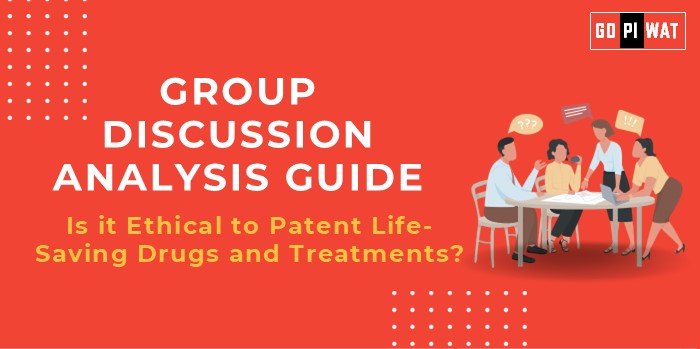📋 Group Discussion (GD) Analysis Guide: Is it Ethical to Patent Life-Saving Drugs and Treatments?
🌐 Introduction to the Topic
- 🔍 Context Setting: The debate around patenting life-saving drugs strikes at the core of ethics in innovation, healthcare equity, and economic sustainability. As pharmaceutical companies invest billions in research, the right to recoup costs often clashes with the urgent need for global access to life-saving treatments.
- 📖 Background: The TRIPS Agreement (1995) under the World Trade Organization (WTO) mandated intellectual property protection globally, including for pharmaceuticals. While fostering innovation, it has led to significant ethical dilemmas, especially in developing countries where affordability remains a major concern.
📊 Quick Facts and Key Statistics
– 💰 Global Pharma R&D Spending: $238 billion (2023) – Reflects high investment in drug development.
– 🌍 Generic Drug Market Share: 80% globally – Indicates importance of alternatives to patented drugs.
– 💊 HIV Treatment Costs: Dropped from $10,000/year to $100/year with generic drugs – Highlights impact of patents and alternatives.
– ⚖️ Patented Drug Access in Low-Income Countries: Less than 10% – Demonstrates disparity in healthcare accessibility.
– 🌍 Generic Drug Market Share: 80% globally – Indicates importance of alternatives to patented drugs.
– 💊 HIV Treatment Costs: Dropped from $10,000/year to $100/year with generic drugs – Highlights impact of patents and alternatives.
– ⚖️ Patented Drug Access in Low-Income Countries: Less than 10% – Demonstrates disparity in healthcare accessibility.
🤝 Stakeholders and Their Roles
- 💼 Pharmaceutical Companies: Innovators investing in R&D, patent holders protecting IP.
- ⚖️ Governments: Regulators ensuring balance between innovation and public access.
- 📢 Non-Governmental Organizations (NGOs): Advocates for affordable access to drugs.
- 🌍 World Trade Organization (WTO): Oversees international patent regulations.
- 👥 Patients and Advocacy Groups: End users lobbying for accessible and affordable treatments.
🏆 Achievements and Challenges
✨ Achievements:
- 💡 Incentivizing Innovation: Patents drive the creation of novel drugs like mRNA COVID-19 vaccines.
- 📈 Economic Growth: The pharmaceutical sector contributes significantly to GDP in countries like the U.S. and Switzerland.
- ❤️ Extended Lifespan: Advances in patented drugs have improved treatment outcomes for diseases like cancer.
⚠️ Challenges:
- 💸 Affordability: Patents lead to high prices, limiting access in low-income regions.
- 🔒 Monopoly Risks: Exclusive rights can stifle competition and innovation.
- 🌍 Global Disparity: Developing nations struggle to afford patented treatments compared to developed countries.
🌍 Global Comparisons:
– Success: India’s Compulsory Licensing: Allowed affordable generic alternatives for cancer drugs like Nexavar.
– Challenge: U.S. Insulin Prices: Remain exorbitantly high due to patent extensions.
📌 Case Study: The HIV/AIDS epidemic saw significant breakthroughs when patent restrictions were lifted for generic drugs in Africa.
🧠 Structured Arguments for Discussion
- ✅ Supporting Stance: “Patents are essential to ensure innovation and recoupment of the substantial investment required for R&D.”
- ❌ Opposing Stance: “Patents prioritize profit over lives, especially in underprivileged regions where affordability is critical.”
- ⚖️ Balanced Perspective: “While patents incentivize innovation, ethical considerations demand reforms to ensure global access to essential drugs.”
🎯 Effective Discussion Approaches
- 📜 Opening Approaches:
- 📈 Statistical Start: “80% of the global generic drug market addresses accessibility gaps left by patents.”
- 🔄 Contrast Introduction: “While patents fuel innovation, millions remain untreated due to prohibitive drug costs.”
- 🔍 Counter-Argument Handling:
- Acknowledge the financial needs of pharma companies.
- Suggest alternatives like tiered pricing or voluntary licensing.
🔍 Strategic Analysis of Strengths and Weaknesses
- 💪 Strengths: Encourages R&D investment; boosts economic growth in the pharma sector.
- ⚠️ Weaknesses: Limits access for economically weaker populations.
- 🚀 Opportunities: Voluntary licensing to improve access; innovations like open-source drug development.
- ⚡ Threats: Public backlash against monopolistic practices; emergence of unregulated counterfeit markets.
🎓 Connecting with B-School Applications
- 🌟 Real-World Applications: Case studies on the balance of business ethics and profitability in healthcare; analysis of public-private partnerships in drug accessibility.
- ❓ Sample Questions:
- “How would you balance profit motives with social responsibility in pharmaceuticals?”
- “What strategies can reduce disparities in access to life-saving drugs?”
- 💡 Insights for B-School Students:
- Explore the business models of pharmaceutical giants for sustainable innovation.
- Analyze the role of government subsidies in enhancing drug accessibility.


